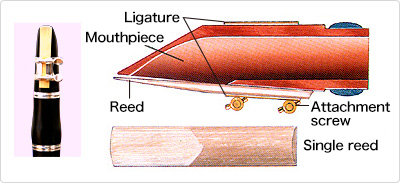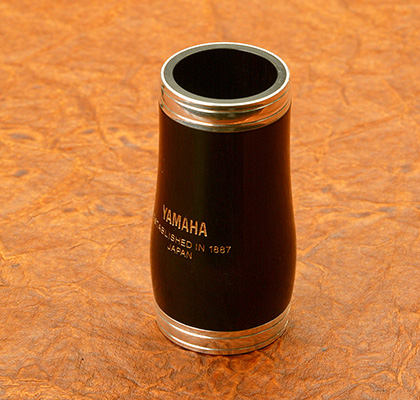The Structure of the Clarinet
The modern clarinet
The mouthpiece of the clarinet
Like the saxophone, the clarinet is an instrument in which sound is produced when the player breathes into the mouthpiece, causing the single reed that is fitted to the mouthpiece to vibrate.

What is that bulge under the mouthpiece?
The bulging section is known as the barrel. This section can be removed.
In German, the barrel is called "die Birne," which means "pear."

The barrel with its central swelling
What does the barrel do?
The barrel serves to adjust the pitch of the sound (how high it is). On a hot day a wind instrument will have a higher pitch, while on cold days its pitch will be lower. Thus, when the pitch is too high, it can be lowered by unscrewing the barrel and extending the tube. Conversely, when the pitch is too low, it can be raised by screwing the barrel in more tightly and shortening the tube.
The barrel is unscrewed by only around 2 mm, however. Try comparing the note before and after unscrewing the barrel. Check the reading on a pitch meter as well, to see how much the pitch has fallen.
Note before unscrewing the barrel
Note after unscrewing the barrel by about 2 mm
When the clarinet is part of an orchestra, other instruments will also be playing, and each instrument will have its own pitch. For this reason, before playing the orchestra tunes first up. However, if an instrument is tuned while cold, it will warm up as it is played and its pitch will gradually rise. Unscrewing the barrel will compensate for this.
In order to tune the clarinet to the other instruments during a performance, the clarinetist will even adjust the instrument during breaks in playing.
Do other wind instruments have barrels?
There are instruments that do not actually have a barrel, but which have a mechanism that performs the same function. For example, the pitch can be adjusted by unscrewing the mouthpiece on a saxophone or the head joint on a recorder or flute.
Musical Instrument Guide:Clarinet Contents
Structure
How the Instrument is Made
Choosing an Instrument
Trivia
- "I Broke My Clarinet" is a French folk song
- Inspiring composers
- In Italy, a single B♭ clarinet
- At one time, most clarinets were made of boxwood
- In vogue in the 1900s-the metal clarinet
- A transparent clarinet?
- Famous clarinet works: concertos
- Famous clarinet works: chamber music
- What is the relationship between hertz and cents?
